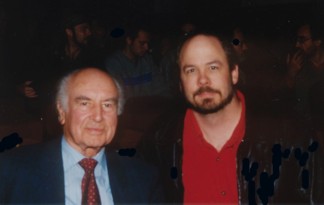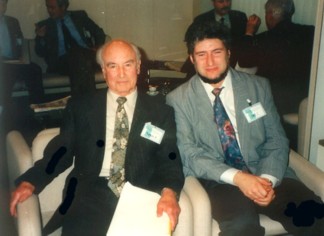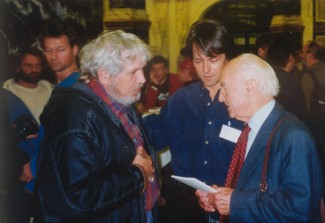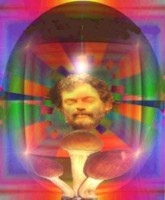Mushroom Pioneers
Chapter 6. Albert Hofmann and the Synthesis of Psilocybine and Psilocine
 |
Fig. 9. Albert Hofmann and Geoffrey Brooke
Amsterdam, Psychoactivity, 1999 |
In 1958, in a spotless laboratory at the Swiss pharmaceutical firm of Sandoz in Basel, this trim 52-year-old research chemist, at the time the Director of Natural Products, performed an unusual experiment. Hofmann had succeeded in isolating and synthesizing two alkaloids first extracted from dried specimens of Psilocybe mexicana Heim. The mushrooms had been grown in vitro in Paris by the eminent French mycologist Roger Heim (Hofmann, 1958; Unsigned, 1959). For two years, Heim had sought unsuccessfully to isolate the active ingredients from the mushrooms. Aware of Hofmann's discovery of LSD, Heim had mailed some 100g of dried P. mexicana to Hofmann. Hofmann and his colleagues, after exhausting this supply of mushrooms, grew their own cultures of P. mexicana and other species.
At first Hofmann and co-workers tried to isolate the active principles of the mushrooms using animal bioassays (mice and dogs), which proved unsuccessful. These experiments were inconclusive inasmuch as the animals were unable to describe the effects the mushrooms, which were not evident to observers. Hofmann had exhausted the bulk of the mushrooms sent to him by Heim, and decided to ingest some of the remaining mushrooms to verify that they were indeed active. Albert Hofmann, the "Father of LSD", thus proceeded to eat 32 dried specimens (2.4 g.) of Psilocybe mexicana which, according to published reports by Wasson and Heim, was roughly equivalent to an average dose used by shamans in México during their curing ceremonies.
 |
Fig. 10. Albert Hofmann and Jochen Gartz
Rovereto, Italy, April, 1992 |
In March of 1959 they published their findings in Experientia. Eight months later, in November of 1958, Drs. A. J. Frey, H. Ott, T. Petrzilka and F. Trozler, all colleagues of Albert Hofmann, then published the chemical structures of psilocybine and psilocine.
The 16 June 1958 issue of Time magazine, reporting on Hofmann's synthesis of psilocybine and psilocine, wrote that he had dissolved five milligrams of pure-white crystals in a test-tube with water and while his colleagues and assistants looked on, had swallowed the potion, lain-down on a couch and waited. Hofmann reported "I am losing my normal bodily sensations. . .My perception of space and time is changing....Your faces appear strange..." and finally, "Now as I close my eyes, I see a wonderful but indistinct kaleidoscopic train of visions. They are vividly colored."
 |
Fig. 11. John W. Allen, Hans van den Hurk and Albert Hofmann
Amsterdam, Psychoactivity, 1998 |
Hofmann reported that the mushroomic alkaloids were related to the natural neurotransmitter serotonine (5-hydroxytryptamine) and that their chemical structure was likewise similar to that of LSD. Hofmann and his colleagues named the substances in the Mexican mushrooms psilocybine and psilocine. The former given the pharmaceutical trade-name as "indocybin (Registered trademark)" in recognition of the Indians who first used the mushrooms. Indo both for the Indians and for indole, the nucleus in the chemical structure of psilocybine; and-cybin after Psilocybe. Sandoz then manufactured pills with 2 and 5 milligram doses of Indolcybin (Registered Trademark).
Three years later (Hofmann, 1980), Hofmann and his wife Anita accompanied Gordon Wasson on an expedition to the Sierra Mazateca where they were received most graciously by the now-famous curandera Doña María Sabina. Wasson, Albert and Anita Hofmann attended a velada and all requested a potion made from the leaves of Salvia divinorum, which gave an experience similar to that of the entheogenic mushrooms, although the duration of the leaves effects were shorter---two-three hours as compared to four-six hours for the mushrooms.
During the velada, Doña María Sabina did not consume the Salvia divinorum but rather partook of Hofmann's Indocybin pills which he later presented to her as a gift. "She was obviously impressed when it was explained to her that we had managed to confine the spirit of the mushrooms in pills." (Hofmann, 1980) María Sabina reportedly consumed 6 of the 5 milligram pills. In the morning she thanked Hofmann for the pills and added that there was no difference between the effects of the pills and the mushrooms, which quite amazed her. She was happy that now she would be able to perform her ceremonies when the mushrooms were out of season. Much later, however, she said she had not really appreciated that the foreigners had taken the power from the mushrooms and recreated it in a laboratory in the form of pills.
Hofmann and colleagues also synthesized various homologues and analogues of psilocybine (CZ-74, CMY-16, and CY19) and psilocine (CY-39 and CX-59), which were also made available for research by Sandoz and later the National Institute of Mental Health (Baer, 1979).
Albert Hofmann also became a collaborator and close friend of Richard Evans Schultes. Over the years they gave lectures at various conferences on entheogenic plants and also wrote two books describing their studies of entheogens (Schultes & Hofmann, 1973; Schultes & Hofmann, 1979).
 |
Image 6.
In Memory of Terrence McKenna, 1946-2000 Graphic Desgin by John W. Allen |

